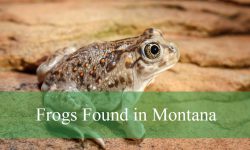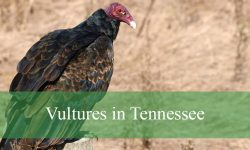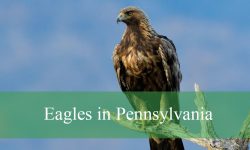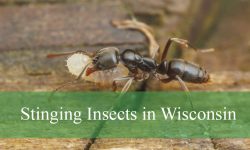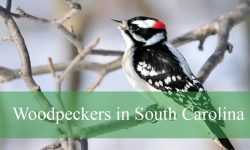Florida is a birdwatcher’s paradise, home to a wide variety of colorful warblers. During migration and breeding seasons, dozens of these vibrant songbirds can be seen across forests, wetlands, and other diverse habitats in the state.
This article will introduce you to 38 species of warblers commonly found or occasionally spotted in Florida. Each species includes photos and identification tips to help you recognize them with ease.
Learning about these warblers will enrich any birdwatching adventure and deepen your appreciation for Florida’s rich and diverse wildlife.
Common Warblers Found in Florida
Black-throated Blue Warbler (Setophaga caerulescens)
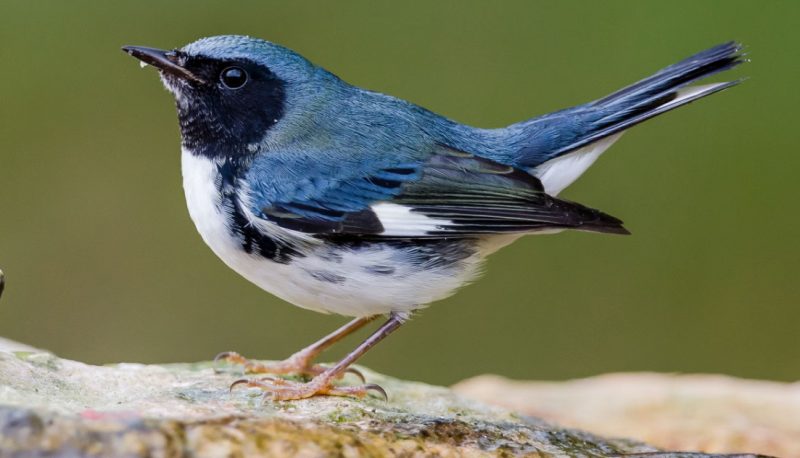
The Black-throated Blue Warbler is a striking species characterized by the male’s deep blue upperparts contrasted with a solid black face and throat, while females are olive-green above with yellowish underparts. The bird measures about 4.3 to 5.1 inches long and has a wingspan close to 7 inches, making it similar in size to other small warblers. Its distinct coloration makes it easier to distinguish in Florida’s forests.
In Florida, this warbler prefers mature deciduous or mixed woodlands, especially during migration and wintering periods. It is less common than some other warblers but can be spotted in dense understory vegetation where it forages. Identification also relies on its sharp, buzzy song and call notes which are often heard before the bird is seen.
Black-throated Blue Warblers are insectivorous, feeding mainly on caterpillars, spiders, and other small invertebrates. Their behavior includes hopping actively through dense shrubs and low trees. During the breeding season in northern areas, they build cup-shaped nests, but in Florida, they are mostly observed during migration or winter in forested habitats that provide ample cover and food.
Yellow Warbler (Setophaga petechia)

The Yellow Warbler is a small, vibrant songbird known for its bright yellow plumage that covers most of its body, making it one of the most recognizable warblers in Florida. Males often display rusty red streaks across their chest, while females tend to be a paler yellow without the streaking. This warbler typically measures about 4.3 to 5.1 inches in length with a wingspan of approximately 7.1 inches.
Identifying the Yellow Warbler is relatively straightforward due to its solid yellow color and cheerful song, which consists of a series of sweet, whistled notes. It has a slender build with a thin, pointed bill suited for catching insects. In Florida, it can be found throughout various habitats including wetlands, mangroves, and shrubby areas, especially during the breeding season and migration periods.
Behaviorally, Yellow Warblers are active and agile, frequently flitting among branches and foliage as they forage for insects and spiders. They build cup-shaped nests often hidden in shrubs or trees near water. Their preference for wet habitats in Florida includes marsh edges, swamps, and even suburban gardens with dense vegetation, where they contribute to controlling insect populations.
Common Yellowthroat (Geothlypis trichas)
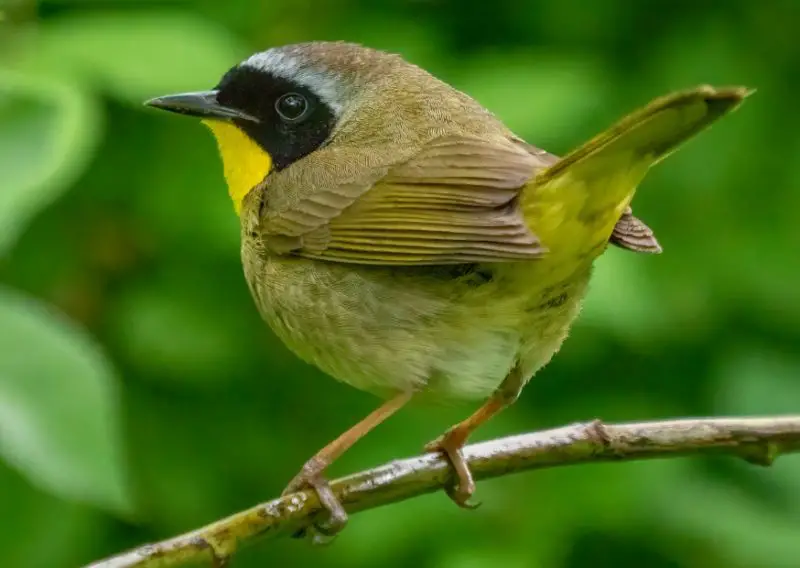
The Common Yellowthroat is a small, lively warbler easily recognized by the male’s striking black mask across the eyes, contrasted with its bright yellow throat and chest. Females and immature birds lack the black mask but maintain the yellow underparts. They typically measure about 4.3 inches in length with a wingspan of around 6.7 inches.
In Florida, the Common Yellowthroat inhabits dense marshes, wet meadows, and shrubby wetlands, where it thrives among thick vegetation. Its secretive nature makes it more often heard than seen, as it emits a distinctive “witchety-witchety” song that resonates through the reeds and bushes. This warbler’s olive-green upperparts help it blend into its lush environment.
Behaviorally, the Common Yellowthroat is highly active, often skulking low in dense vegetation while foraging for insects, including flies, beetles, and caterpillars. It builds nests close to or on the ground in thick cover to avoid predators. Its presence in Florida’s wetlands highlights the importance of these habitats for breeding and foraging during migration.
Magnolia Warbler (Setophaga magnolia)
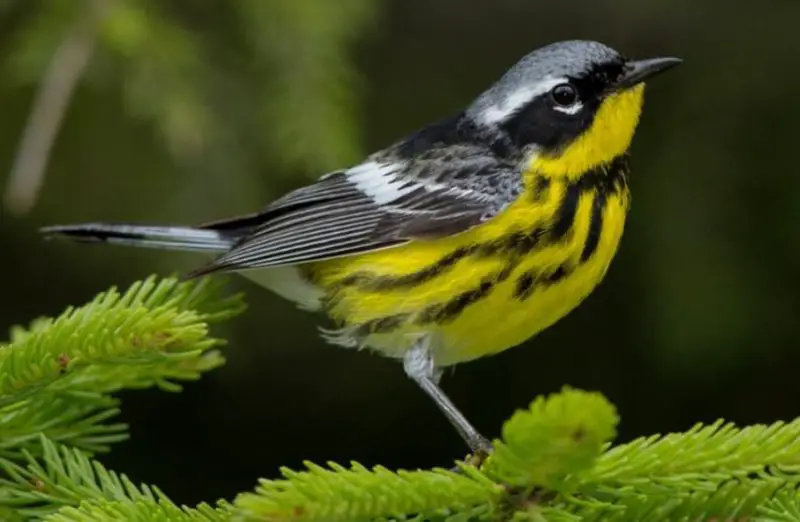
The Magnolia Warbler is known for its striking black and yellow plumage, with males displaying a bold pattern of black streaks on a yellow breast and a distinct black mask across the face. Females are more subdued with grayish upperparts but maintain the yellow underparts. This species measures approximately 4.3 to 5.1 inches long with a wingspan of around 7 inches.
In Florida, Magnolia Warblers are typically seen during migration in forested habitats with dense understory. They prefer areas with young conifers or mixed woodlands, where they glean insects from branches and leaves. Their bright colors and unique markings make them relatively easy to identify among other warblers passing through the region.
Magnolia Warblers are active and energetic foragers, hopping and fluttering through foliage in search of caterpillars, spiders, and other small insects. They often flick their tails downward while moving rapidly. Though they breed further north, Florida provides crucial stopover habitat during migration, making it a key location for observing this species in transit.
Ovenbird (Seiurus aurocapilla)
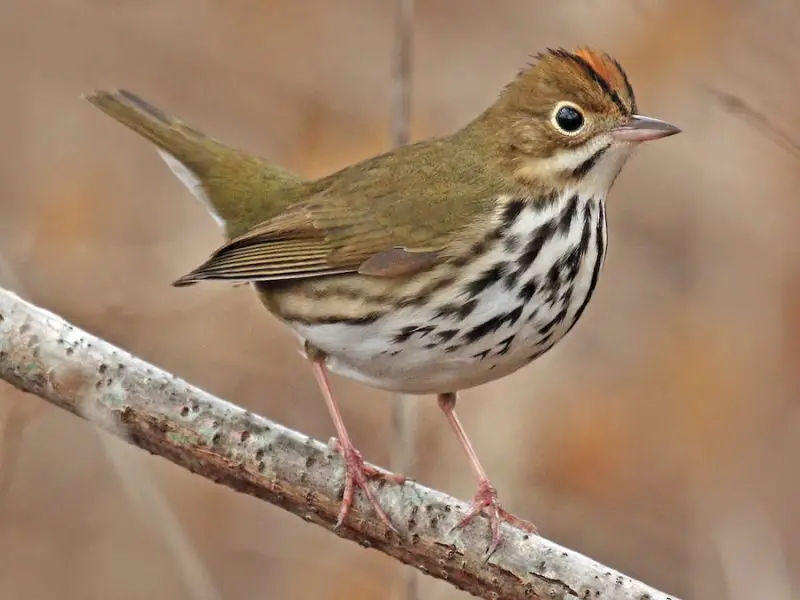
The Ovenbird is a distinctive warbler with an olive-brown back and strikingly spotted white underparts, along with an orange crown bordered by black stripes, resembling a small oven—hence the name. It measures about 5.1 to 5.5 inches in length with a wingspan near 8.7 inches, making it slightly larger than many other warblers.
In Florida, Ovenbirds favor mature forests with thick leaf litter and dense undergrowth, often seen walking on the forest floor rather than hopping through the trees. Their loud, ringing “teacher-teacher-teacher” song is a common sound in Florida woodlands during breeding and migration seasons, helping to locate them despite their cryptic coloration.
Ovenbirds forage primarily on the ground, flipping leaves to find insects, spiders, and other invertebrates. Their behavior is unique among warblers because of their terrestrial habits. Florida’s deciduous and mixed forests provide essential habitat for Ovenbirds during migration and winter, highlighting the state’s role in supporting diverse woodland bird species.
Chestnut-sided Warbler (Setophaga pensylvanica)

The Chestnut-sided Warbler is a small, vibrant bird notable for its bright yellow crown and sides streaked with rich chestnut patches during the breeding season. It measures around 4.3 to 5 inches in length, with a wingspan of approximately 7 inches. The males display striking plumage with a white breast and black streaks on the back, while females tend to have duller coloration. This warbler’s bold colors make it stand out during migration in Florida.
In Florida, the Chestnut-sided Warbler is primarily seen during migration periods as it travels between its northern breeding grounds and wintering sites in Central America. It frequents open woodlands, forest edges, and shrubby areas, often favoring second-growth forests or young hardwood stands where it can easily forage. Its sharp, buzzy song and distinct “pleased, pleased, pleased to meetcha” call are useful for identification.
Behaviorally, this species is active and agile, gleaning insects from leaves and twigs. It moves quickly through the mid to upper levels of trees and shrubs, occasionally fluttering its wings to startle prey. In Florida, Chestnut-sided Warblers contribute to insect control during their brief stopovers, highlighting the importance of healthy forest habitats in migration corridors.
Blackburnian Warbler (Setophaga fusca)
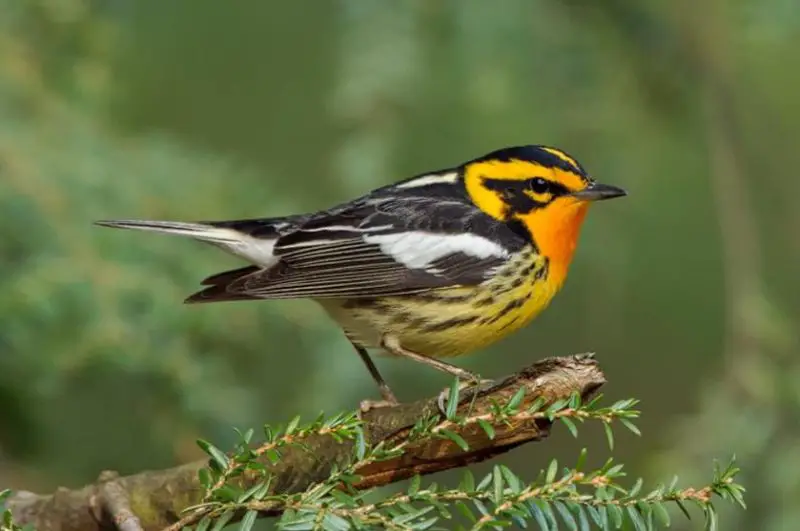
The Blackburnian Warbler is known for its striking, fiery orange throat and face, contrasted with black and white patterns on its back and wings. Males exhibit the most vivid coloration, while females and immature birds have paler orange and yellow tones. This medium-sized warbler measures about 4.5 to 5.1 inches long, with a wingspan near 7.5 inches.
In Florida, Blackburnian Warblers are mostly passage migrants and occasional winter visitors. They prefer mature coniferous and mixed forests during their stopovers, often seen high in the canopy where their bright colors can be spotted against the green foliage. Their thin, pointed bills help them pick insects from pine needles and small branches.
Behaviorally, Blackburnian Warblers are active and somewhat shy, moving quickly through tree canopies while feeding on caterpillars, beetles, and spiders. They produce a high-pitched, buzzy song that can aid in detection. Florida’s forested areas serve as critical resting and feeding habitats during the lengthy migratory journey these birds undertake each year.
Black-and-white Warbler (Mniotilta varia)

The Black-and-white Warbler is a unique warbler species with striking black and white stripes running along its body, resembling a tiny woodpecker. Measuring approximately 4.3 to 5 inches in length with a wingspan around 7 inches, it is one of the few warblers known for creeping along tree trunks and branches rather than hopping through foliage.
In Florida, this species is found year-round in various wooded habitats, including deciduous and mixed forests, woodlots, and sometimes urban parks with mature trees. Its distinctive behavior and contrasting plumage make it easier to identify, even when it blends with the bark. The Black-and-white Warbler’s song is a series of high-pitched notes that speed up into a buzzy trill.
Behaviorally, it forages by climbing up and down tree trunks and large branches, searching for insects, spiders, and larvae hidden in bark crevices. This unique feeding style sets it apart from most other warblers. In Florida, the Black-and-white Warbler contributes to controlling insect pests in forest ecosystems and adapts well to different wooded environments.
Pine Warbler (Setophaga pinus)
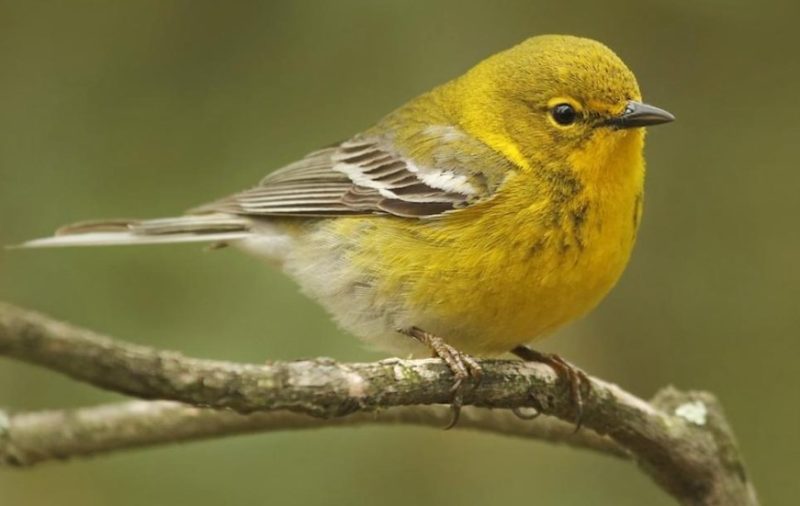
The Pine Warbler is a medium-sized warbler with olive-green upperparts and bright yellow underparts, especially vivid in males. It measures about 5.1 inches long with a wingspan of roughly 7.5 inches, making it one of the larger warblers commonly seen in Florida. Unlike many warblers that prefer hardwoods, the Pine Warbler is closely associated with pine forests.
In Florida, this species is a resident and breeder in pine-dominated habitats, such as longleaf pine forests and pine plantations. It is often seen perched high in pine trees, where it forages for insects and seeds. The Pine Warbler’s song is a musical trill that can be heard throughout its range, making it easier to locate.
Behaviorally, Pine Warblers are relatively calm compared to other warblers, often creeping along branches or hanging upside down while searching for food. They have a varied diet that includes insects, pine seeds, and berries. Their strong association with pine forests highlights the importance of conserving these habitats in Florida for maintaining native bird diversity.
Tennessee Warbler (Leiothlypis peregrina)
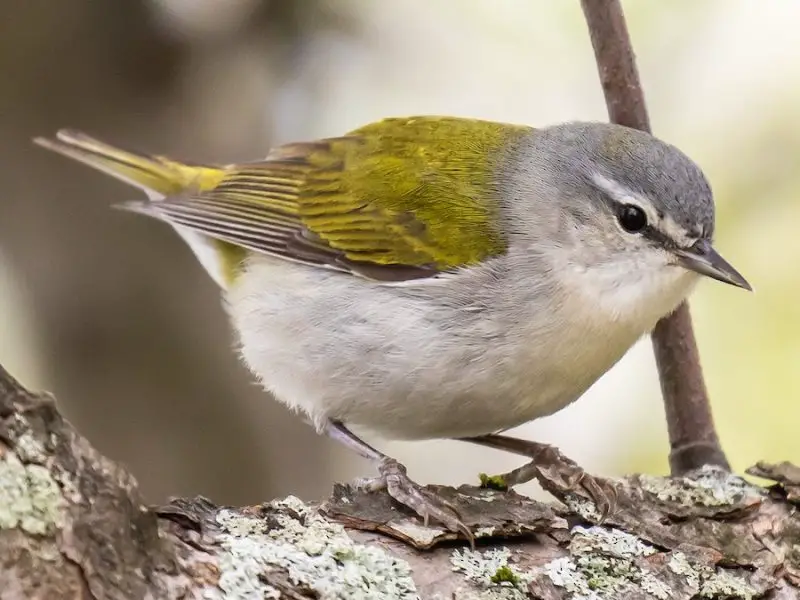
The Tennessee Warbler is a small, slender bird with a mostly olive-green back and pale underparts, occasionally tinged with yellow. It measures about 4.3 to 4.7 inches in length and has a wingspan close to 7 inches. This warbler lacks striking field marks, but its subtle coloration and active behavior help in identification during migration.
In Florida, Tennessee Warblers are primarily migrants passing through in spring and fall, though some may winter in southern parts of the state. They prefer open woodlands, forest edges, and shrubby areas, often foraging in the canopy where they glean insects and caterpillars from leaves.
Behaviorally, Tennessee Warblers are very active and fast-moving, constantly fluttering their wings and hopping from branch to branch as they feed. Their thin, pointed bills are well adapted for catching small insects. Florida’s diverse forest habitats provide important stopover and wintering sites that support these warblers during their long migratory journeys.
Blackpoll Warbler (Setophaga striata)
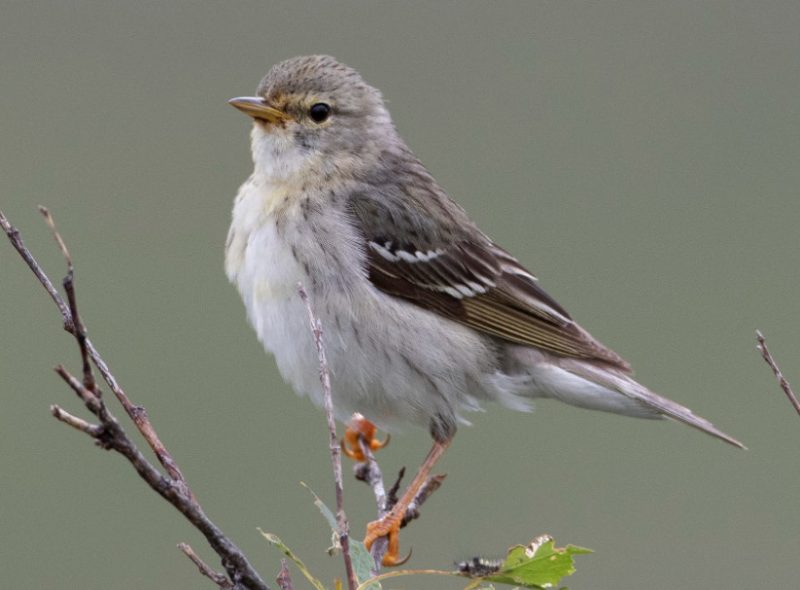
The Blackpoll Warbler is a small but striking warbler, particularly during fall migration when males display bold black and white streaking across their backs and flanks, with a white belly and black cap. Females and immature birds tend to be duller with brownish tones but maintain the streaked pattern. This species measures about 4.3 to 5 inches long with a wingspan near 7.5 inches.
In Florida, Blackpoll Warblers are most commonly seen during their impressive fall migration, stopping briefly to refuel before continuing their long overwater journey to South America. They favor wooded habitats such as pine forests, mangroves, and coastal thickets. Their distinctive, sharp chip call and buzzy song help birders detect them even when they are hidden among foliage.
Behaviorally, Blackpoll Warblers are active foragers, gleaning insects and spiders from tree branches and leaves. They exhibit swift, restless movements and are often found in mixed-species flocks during migration. Florida’s habitats play a vital role as staging areas that support their demanding migratory flights.
Palm Warbler (Setophaga palmarum)

The Palm Warbler is a medium-sized warbler characterized by its olive-brown upperparts, bright yellow underparts, and distinctive rusty-colored cap visible on males. It measures about 5 inches in length with a wingspan around 7 inches. This species is notable for its tail-wagging behavior, constantly flicking its tail up and down as it forages.
In Florida, Palm Warblers are common winter residents and migrants, often found in open habitats such as pine flatwoods, scrublands, and coastal marshes. They prefer low shrubs and ground-level foraging sites, which sets them apart from many other warblers that prefer canopy feeding. Their sharp “chippy” call and buzzy song can be heard in these habitats.
Behaviorally, Palm Warblers actively probe leaf litter and low vegetation for insects, spiders, and seeds. Their tail-wagging motion is thought to help flush prey from hiding places. In Florida’s varied habitats, they are among the more frequently observed warblers during cooler months, showcasing adaptability to different environments.
Cape May Warbler (Setophaga tigrina)

The Cape May Warbler is a brightly colored warbler distinguished by its yellow face and underparts with bold black streaks, and males show a rusty orange patch on the cheeks. It measures roughly 4.3 to 4.7 inches in length, with a wingspan near 7 inches. Its slim, slightly curved bill is specialized for feeding on spruce budworms and other insects.
During migration and winter, Cape May Warblers visit Florida, often favoring woodland edges, pine forests, and citrus groves. They are less common than some other warblers but are easily identified by their unique coloration and soft, buzzing song. They typically forage high in trees but may also be seen lower when feeding.
Behaviorally, Cape May Warblers are active gleaners, focusing on insects and spiders caught from needles and leaves. Their feeding habits are closely tied to insect outbreaks in coniferous forests, but in Florida, they adapt by exploiting a variety of habitats. Their presence in Florida is crucial during migration as a stopover for refueling.
Bay-breasted Warbler (Setophaga castanea)

The Bay-breasted Warbler is a medium-sized warbler recognized by its chestnut-colored breast and sides, contrasting with a white belly and black-and-white streaked back. Males have more pronounced chestnut coloring, while females are paler. This bird measures approximately 4.3 to 5 inches long with a wingspan near 7 inches.
In Florida, Bay-breasted Warblers are primarily migrants, passing through on their way to wintering grounds in Central and South America. They prefer mature hardwood and mixed forests, where they forage actively among the canopy. Their song is a series of sharp, buzzy notes that help in locating them.
Behaviorally, Bay-breasted Warblers feed mainly on insects, especially caterpillars and larvae. During migration, they may join mixed-species feeding flocks, actively moving through foliage to find prey. Florida’s forested areas provide vital stopover habitats that support their long-distance migration.
Yellow-rumped Warbler (Setophaga coronata)
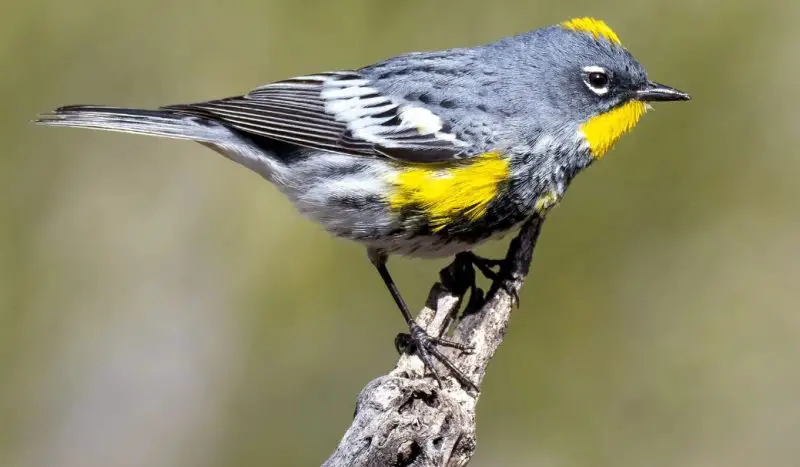
The Yellow-rumped Warbler is a versatile and abundant warbler species, easily identified by the bright yellow patches on its rump and sides, grayish-blue back, and white throat and belly. It measures about 5 to 5.5 inches in length with a wingspan close to 8.5 inches. Both sexes have similar plumage, with males often showing brighter colors during breeding.
In Florida, Yellow-rumped Warblers are common winter residents and migrants, found in a wide variety of habitats including forests, coastal scrub, and urban parks. Their adaptability allows them to feed on insects, berries, and seeds, making them one of the few warblers able to survive colder months by eating fruit like bayberries.
Behaviorally, they are active foragers that glean insects from leaves and branches but also hover to catch prey in midair. Their distinctive call notes and buzzy songs are often heard throughout Florida’s woodlands during the cooler seasons. Their ability to exploit diverse food sources contributes to their wide distribution and population success.
Nashville Warbler (Leiothlypis ruficapilla)
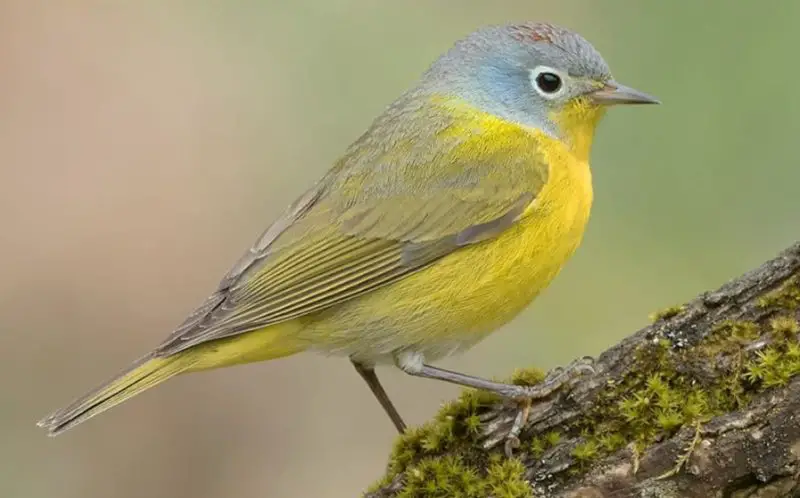
The Nashville Warbler is a small, slender bird measuring about 4.3 to 5 inches in length with a wingspan near 7 inches. It features a gray head, olive-green back, and bright yellow underparts. One of its distinctive traits is the white eye ring that encircles its dark eyes, giving it a somewhat wide-eyed appearance. Males and females have similar plumage, making identification reliant on subtle features and song.
In Florida, Nashville Warblers are mostly seen during migration, passing through wooded habitats such as hardwood forests, pine-oak woods, and shrubby edges. They prefer areas with dense undergrowth where they can forage for insects and spiders. Their song is a soft, sweet trill that can be heard amidst the rustling leaves.
Behaviorally, Nashville Warblers are active foragers that flit quickly through foliage, gleaning insects from leaves and twigs. They often feed in the mid to upper canopy but will occasionally move lower during migration stopovers. Florida’s forests provide important resting and feeding sites that support these birds on their long migratory journeys.
Canada Warbler (Cardellina canadensis)

The Canada Warbler is a strikingly patterned species, measuring about 4.3 to 5 inches in length with a wingspan of roughly 7 inches. It has a slate-gray back, bright yellow throat and chest, and distinctive bold black necklace-like streaks across the chest. The bird’s large white eye ring gives it an alert expression, helping birders identify it despite its elusive nature.
In Florida, Canada Warblers are primarily passage migrants and occasional winter visitors. They prefer dense, moist forests and shrubby wetlands where thick understory vegetation offers cover and abundant insect prey. Their rapid, buzzy song can be difficult to hear but is key to locating them in dense habitats.
Behaviorally, Canada Warblers are shy and secretive, often skulking low in tangled vegetation as they forage. They glean insects, spiders, and larvae, moving quickly through shrubs and low branches. Florida’s wet woodlands and swamps provide crucial habitat during migration, supporting this species’ survival during long journeys.
Mourning Warbler (Geothlypis philadelphia)
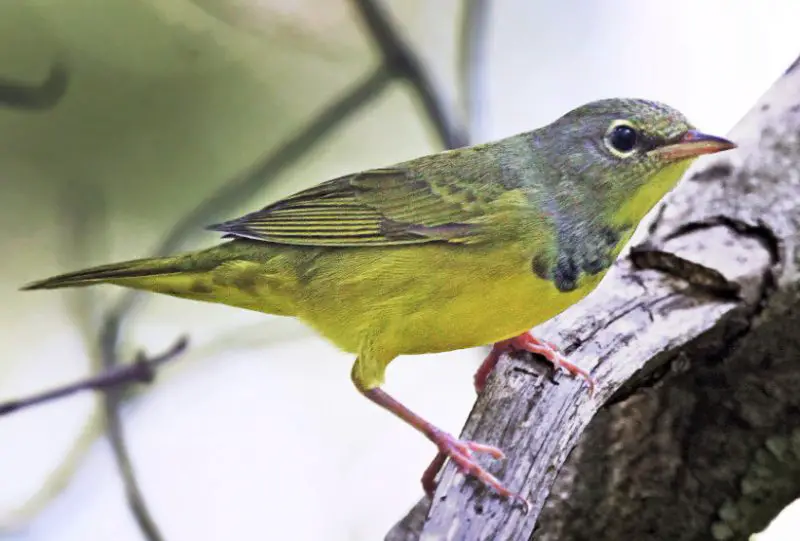
The Mourning Warbler is a medium-sized warbler about 4.7 to 5.1 inches long, recognizable by its olive-green upperparts and pale yellow underparts. Males have a distinctive black patch on the throat and upper chest, bordered by gray on the face, while females and juveniles lack the throat patch but maintain similar coloring. Its relatively plain appearance can make it easy to overlook.
In Florida, Mourning Warblers are mostly seen during spring and fall migration, favoring dense thickets, forest edges, and second-growth forests. They prefer habitats with thick underbrush where they can hide and forage for insects. Their quiet, buzzing song is often heard but not easily located due to their secretive behavior.
Behaviorally, Mourning Warblers are active ground and low-vegetation foragers, searching for caterpillars, beetles, and other small insects. They tend to remain hidden in dense cover, making sightings challenging. Florida’s shrubby habitats provide essential stopover areas where these warblers can refuel during their migration.
Kentucky Warbler (Geothlypis formosa)
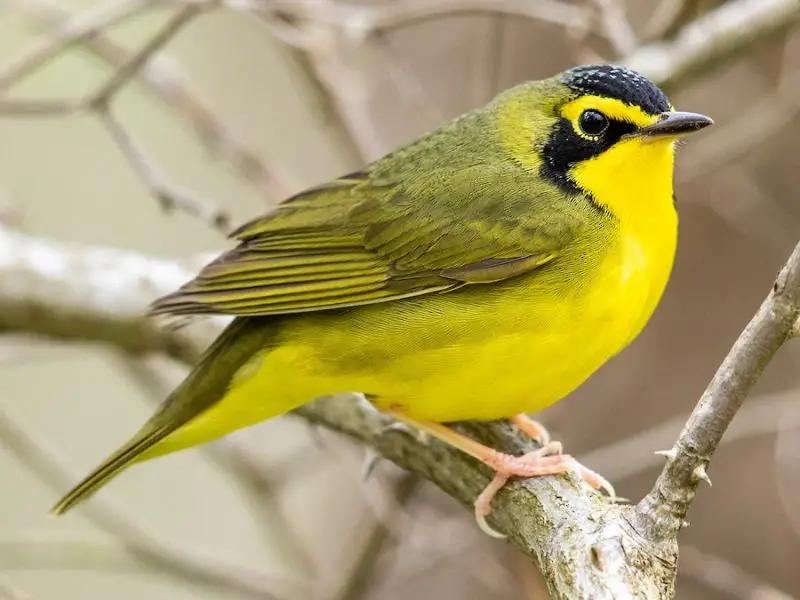
The Kentucky Warbler is a strikingly colored warbler measuring about 4.7 to 5.1 inches in length with a wingspan near 7.5 inches. It features olive-green upperparts, bright yellow underparts, and a distinctive black “mask” across the eyes and down the sides of the neck. This species is relatively large and robust for a warbler.
In Florida, Kentucky Warblers are primarily passage migrants, often found in dense deciduous forests and bottomlands with thick understory. They prefer shaded, moist habitats rich in leaf litter where they forage on the ground and low vegetation. Their song is a loud, ringing “sweet-sweet-sweet, I’m so sweet,” which helps with identification.
Behaviorally, Kentucky Warblers are ground feeders, actively flipping leaves and probing soil for insects, spiders, and other invertebrates. Their secretive nature means they are more often heard than seen. Florida’s mature forest habitats provide vital stopover points during migration, supporting this species’ energy needs.
Wilson’s Warbler (Cardellina pusilla)
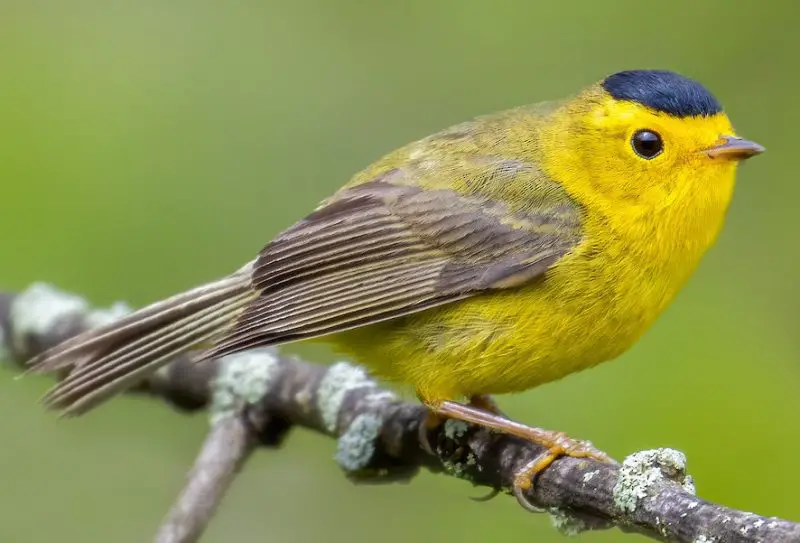
Wilson’s Warbler is a small, compact warbler measuring about 4 to 4.7 inches in length with a wingspan of about 6.7 inches. It is easily recognized by its bright yellow face and underparts, olive-green back, and a distinctive small black cap on the crown of males. Females and juveniles are similar but often lack the pronounced black cap.
In Florida, Wilson’s Warblers are primarily migrants, passing through forests, woodlands, and shrubby areas during spring and fall. They favor moist habitats with dense undergrowth, such as thickets and riparian zones. Their sharp, high-pitched “zeep” call and simple song aid birders in detection.
Behaviorally, Wilson’s Warblers are energetic and restless foragers, flitting actively through low vegetation to glean insects and spiders. They often join mixed-species flocks during migration. Florida’s diverse forest habitats provide crucial stopover areas that support these tiny migrants on their long journeys.
Louisiana Waterthrush (Parkesia motacilla)
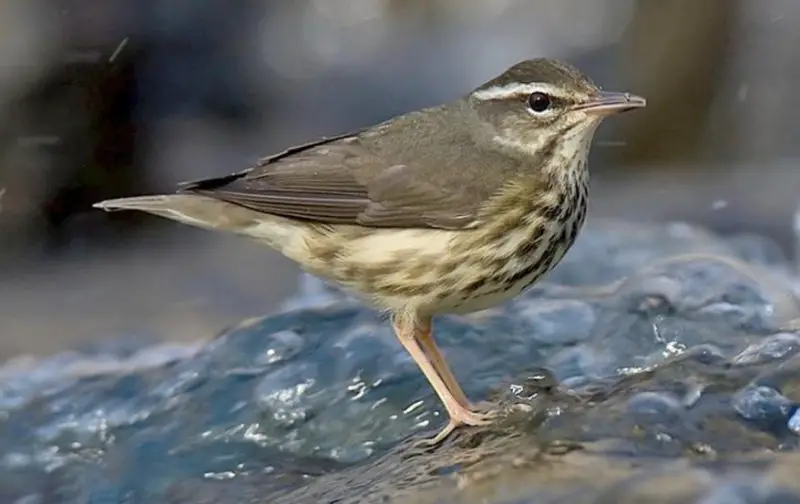
The Louisiana Waterthrush is a robust warbler measuring about 5.1 to 5.5 inches in length with a wingspan close to 8.3 inches. It has brownish-olive upperparts, a white throat and underparts streaked with dark brown, and distinct white “spectacles” around the eyes. This bird is notable for its strong legs and relatively long tail, adaptations for its ground-foraging lifestyle.
In Florida, Louisiana Waterthrushes favor fast-flowing streams and shaded, forested wetlands, where they are typically found near clean, clear water. They breed in dense riparian woodlands and are often seen walking or bobbing along the edges of streams and rivers. Their loud, clear song, which includes ringing whistles and trills, echoes through their watery habitats.
Behaviorally, this species forages mainly on aquatic insects, small crustaceans, and larvae, flipping over leaves and probing beneath stones in shallow water. It moves actively both on the ground and low branches, demonstrating a preference for riparian zones. Florida’s healthy stream corridors provide essential breeding and feeding habitats for this species.
Northern Waterthrush (Parkesia noveboracensis)
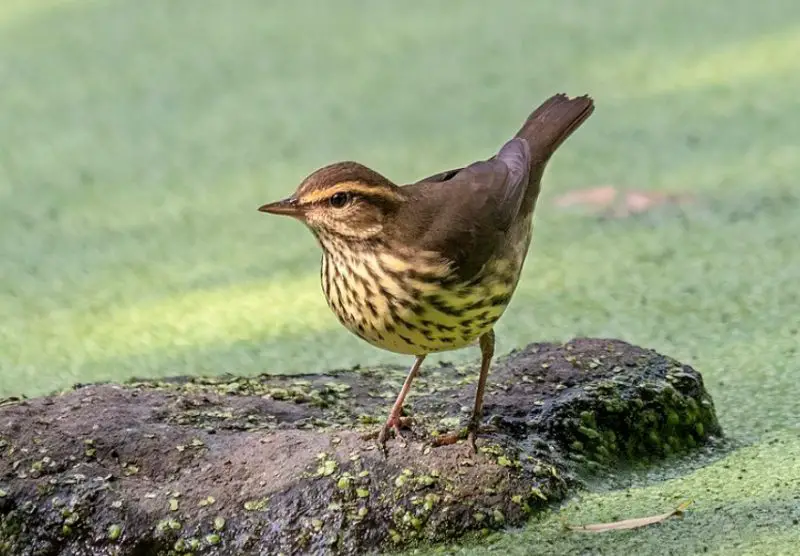
The Northern Waterthrush is a medium-sized warbler measuring around 5 to 5.5 inches long with a wingspan of about 8 inches. It has olive-brown upperparts, heavily streaked white underparts, and a prominent white eyebrow stripe contrasting with a dark eye line. Its build is sturdy, with strong legs well suited for walking along forest floors and stream edges.
In Florida, Northern Waterthrushes are commonly found during migration and wintering periods, occupying swampy woodlands, flooded forests, and mangroves. They prefer moist habitats rich in leaf litter and shallow water where they hunt for aquatic and terrestrial insects. Their loud, sharp “chink” call and a series of high-pitched notes characterize their vocalizations.
Behaviorally, this species actively searches for food by walking or running on the ground and in shallow water, flipping leaves and probing for prey. Its diet includes insects, spiders, and small crustaceans. Florida’s wetlands and floodplain forests provide important stopover and winter habitats that support the Northern Waterthrush’s life cycle.
Worm-eating Warbler (Helmitheros vermivorum)
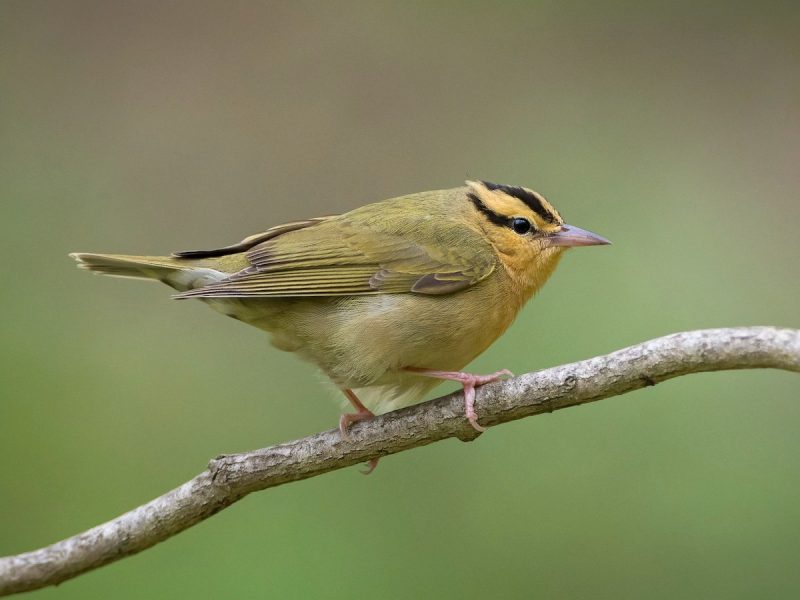
The Worm-eating Warbler is a small, secretive bird about 4.3 to 5 inches in length with a wingspan near 7.5 inches. It is characterized by its warm brown upperparts, pale underparts, and distinctive black stripes on its crown and sides of the neck. Unlike many warblers, it has a slender, slightly curved bill specialized for picking insects from bark and leaf litter.
In Florida, this species inhabits mature deciduous and mixed forests, especially in hilly or rocky areas during migration and winter. It prefers dense understory with plenty of leaf litter where it forages quietly. Its song is a series of short, buzzy trills that can be difficult to hear in thick vegetation.
Behaviorally, Worm-eating Warblers feed mainly on caterpillars, beetles, and other insects found in leaf litter and bark crevices. They move deliberately along the ground and low branches, often flicking their tails while searching for food. Florida’s forested habitats with abundant leaf litter provide essential wintering grounds for this species.
Connecticut Warbler (Oporornis agilis)
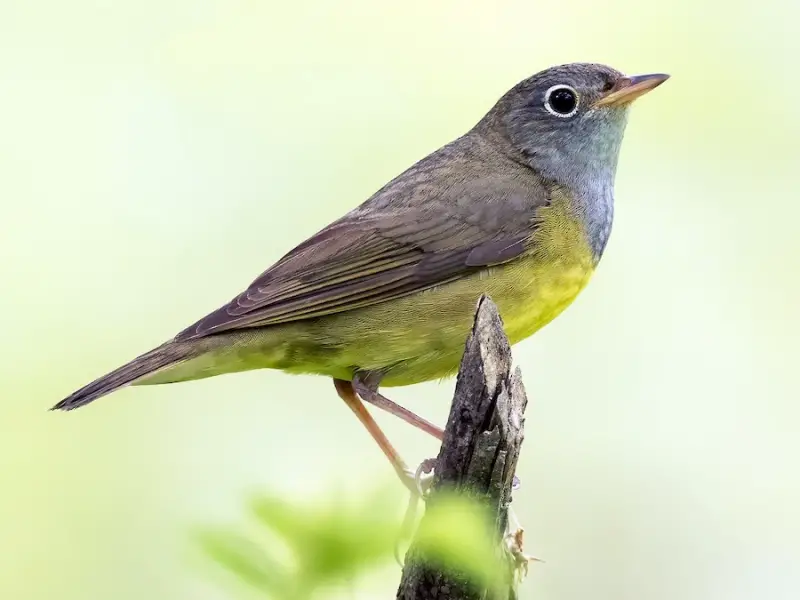
The Connecticut Warbler is a medium-sized, shy warbler measuring approximately 4.7 to 5.1 inches long with a wingspan near 7.5 inches. It has olive-gray upperparts, bright yellow underparts, and a distinctive white eye ring. Its plain but striking coloration and secretive behavior make it one of the more challenging warblers to spot in Florida.
In Florida, Connecticut Warblers are mostly seen during migration and occasional wintering in dense, shrubby forests, thickets, and swampy woodlands. They prefer thick understory vegetation where they remain hidden while foraging. Their song is a loud, clear series of whistles, but they are more often heard than seen due to their secretive nature.
Behaviorally, Connecticut Warblers feed on insects and spiders, gleaning prey from leaves and low branches. They are ground and low-vegetation foragers, moving cautiously and avoiding open spaces. Florida’s dense forest habitats provide critical stopover sites for this species during migration.
Hooded Warbler (Setophaga citrina)
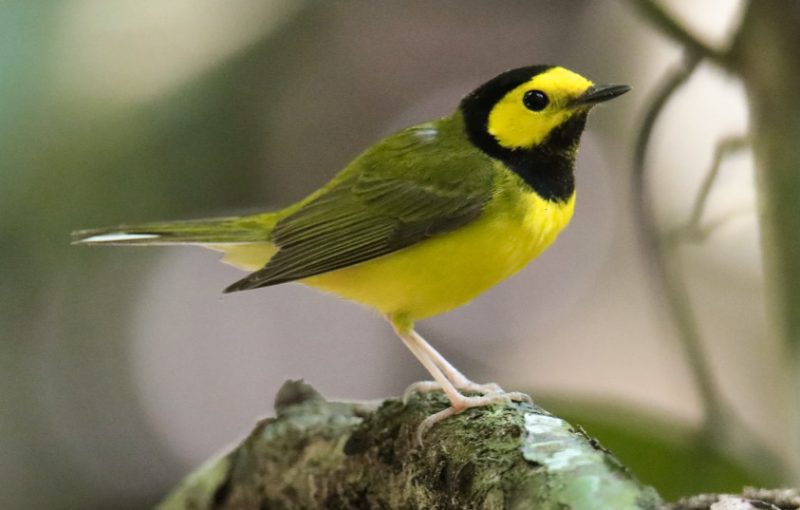
The Hooded Warbler is a medium-sized warbler measuring about 4.7 to 5.1 inches in length with a wingspan close to 7 inches. Males are easily recognized by their bright yellow face and underparts contrasted with a bold black “hood” covering the head and throat. Females are similar but lack the full black hood, often showing a grayish head instead.
In Florida, Hooded Warblers breed in mature deciduous and mixed forests with dense understory, especially in the northern and central parts of the state. They prefer shaded, moist woods where they sing their distinctive loud “wichety wichety wichety” song to defend territories. They also appear during migration in a variety of forested habitats.
Behaviorally, Hooded Warblers forage actively in the understory, gleaning insects, spiders, and other small invertebrates from leaves and branches. They often flick their tails while moving through dense vegetation. Florida’s forest habitats are crucial for the breeding success and survival of this visually striking species.
Swainson’s Warbler (Limnothlypis swainsonii)

Swainson’s Warbler is a secretive, medium-sized warbler measuring about 5 to 5.5 inches in length with a wingspan near 8 inches. It has warm brown upperparts, a pale buffy underside, and a subtle, plain face with a faint eye stripe. Unlike many colorful warblers, its muted plumage helps it blend into dense understory vegetation, making it difficult to spot.
In Florida, Swainson’s Warblers inhabit dense thickets, swamps, and bottomland hardwood forests with heavy leaf litter and thick undergrowth. They prefer moist, shaded habitats near water, where they breed and forage. Their loud, descending series of whistles, often described as “wee-see, wee-see, wee-see,” can be heard echoing through their preferred habitats.
Behaviorally, these warblers are primarily ground and low-vegetation foragers, feeding on insects, spiders, and snails hidden in leaf litter. Their skulking nature and preference for dense cover make them elusive to birders, but Florida’s extensive wetland forests provide essential breeding and wintering habitat for this species.
Cerulean Warbler (Setophaga cerulea)

The Cerulean Warbler is a small, striking bird about 4.3 to 5 inches long with a wingspan around 7.5 inches. Males are vibrant sky-blue above with white underparts and black streaking on the sides, while females and juveniles are more muted greenish-blue. This species is known for its delicate build and fast, fluttering flight high in the forest canopy.
In Florida, Cerulean Warblers are rare but occasionally seen during migration, favoring mature deciduous and mixed forests with tall trees and open canopies. They forage high in the canopy, often joining mixed-species flocks. Their thin, high-pitched song is a soft, buzzy trill that can be difficult to detect.
Behaviorally, Cerulean Warblers glean insects and caterpillars from leaves and twigs, favoring the upper canopy for feeding and nesting. Due to habitat loss in their breeding grounds, their numbers have declined, making Florida’s forested habitats important stopover areas during migration.
Prothonotary Warbler (Protonotaria citrea)

The Prothonotary Warbler is a brightly colored, medium-sized warbler measuring about 5 to 5.5 inches in length with a wingspan near 8 inches. It has vivid golden-yellow plumage covering its head and underparts, with blue-gray wings and tail. Its bold coloration makes it one of the most visually striking warblers in Florida.
In Florida, Prothonotary Warblers are year-round residents in swampy forests, flooded woodlands, and mangroves, particularly favoring wooded wetlands with standing water. They nest in cavities or nest boxes near water and are often seen flitting low among trees and shrubs near streams or ponds.
Behaviorally, these warblers forage actively for insects, spiders, and small crustaceans along tree trunks, branches, and around water edges. Their distinctive, ringing “sweet sweet sweet” song and bright coloration make them a favorite among birdwatchers. Florida’s wetlands provide critical habitat for their breeding and survival.
Golden-winged Warbler (Vermivora chrysoptera)
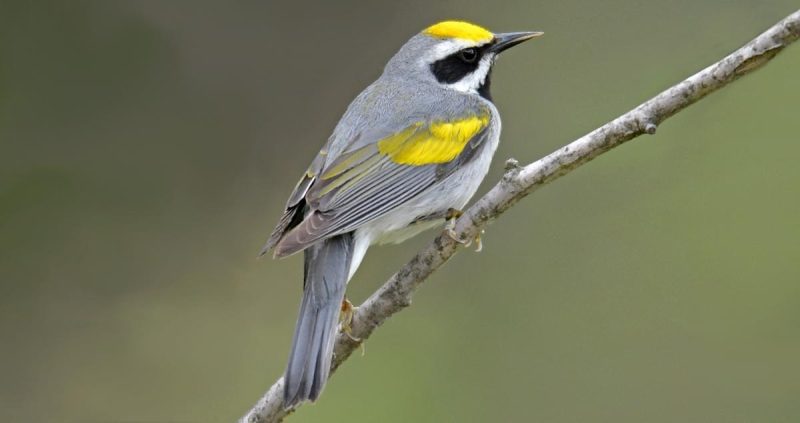
The Golden-winged Warbler is a small, striking bird about 4.3 to 4.7 inches long with a wingspan near 7 inches. Males display gray bodies with bold black throats, white underparts, and bright yellow wing patches and crowns. Females are duller, lacking the black throat but retaining yellow wing markings. This species’ contrasting colors make it unique among warblers.
In Florida, Golden-winged Warblers are rare migrants and possible occasional breeders in young, early-successional forests and shrubby habitats. They prefer areas with abundant low vegetation and open patches. Their buzzy, buzzy, buzzy song and sharp chip notes aid in locating them.
Behaviorally, these warblers actively forage for caterpillars, moth larvae, and other insects in dense foliage. Due to habitat loss and hybridization with Blue-winged Warblers, their populations have declined, making Florida’s suitable habitats important for their conservation during migration.
Blue-winged Warbler (Vermivora cyanoptera)
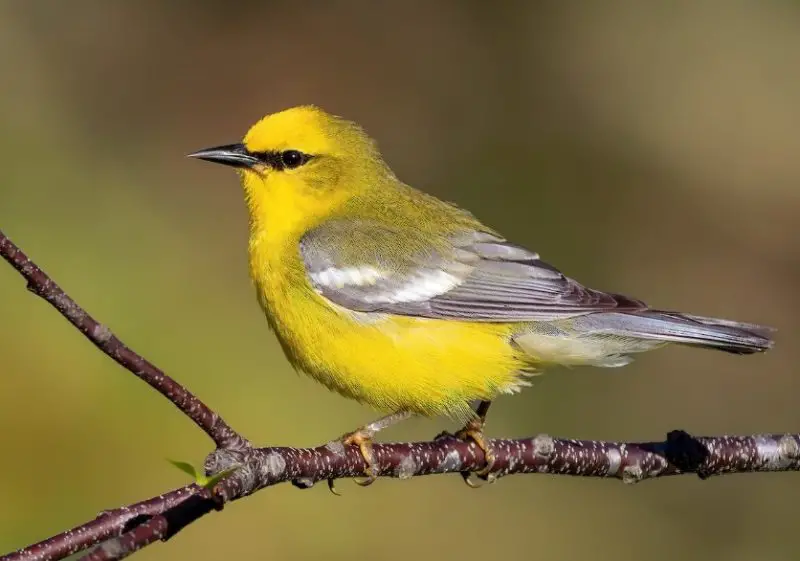
The Blue-winged Warbler is a small, brightly colored warbler measuring about 4.3 to 5 inches in length with a wingspan of approximately 7 inches. Males have bright yellow underparts and face, olive-green backs, and distinct blue-gray wings, while females are generally duller with less vivid coloration.
In Florida, Blue-winged Warblers are common migrants and occasional breeders in open woodlands, shrubby fields, and young forests with dense low growth. They favor habitats with abundant vines and brushy patches. Their loud, buzzing “bee-buzz” song is characteristic and helps with detection.
Behaviorally, Blue-winged Warblers forage actively in low vegetation, gleaning insects and spiders. They build cup-shaped nests on or near the ground hidden in thick vegetation. Florida’s early successional habitats provide important breeding and migratory stopover sites for this adaptable species.
Louisiana Waterthrush (Parkesia motacilla)

The Louisiana Waterthrush is a robust warbler measuring about 5.1 to 5.5 inches in length with a wingspan close to 8.3 inches. It has brownish-olive upperparts, a white throat and underparts streaked with dark brown, and distinct white “spectacles” around the eyes. Its strong legs and relatively long tail make it well adapted for its ground-foraging lifestyle along streams.
In Florida, this species is commonly found in forested wetlands and along clean, fast-flowing streams, where it breeds and forages. It prefers shaded riparian habitats with abundant leaf litter and rocks. Its loud, ringing song, consisting of clear whistles and trills, is frequently heard echoing through these wooded waterways.
Behaviorally, the Louisiana Waterthrush actively searches for aquatic insects, larvae, and small crustaceans by flipping leaves and probing under stones in shallow water. Its steady movements along stream edges and unique song make it a distinctive inhabitant of Florida’s riparian forests.
Ovenbird (Seiurus aurocapilla)

The Ovenbird is a medium-sized warbler about 5.1 to 5.5 inches long with a wingspan near 8.7 inches, larger than many other warblers. It features olive-brown upperparts, heavily spotted white underparts, and a striking orange crown bordered by black stripes, resembling a small oven, which inspires its name.
In Florida, Ovenbirds are found in mature deciduous and mixed forests, favoring shaded woodlands with thick leaf litter. They spend much of their time on the forest floor, walking or running rather than hopping. Their loud, ringing “teacher-teacher-teacher” song is often the best clue to their presence.
Behaviorally, Ovenbirds forage mainly on the ground, flipping leaves and searching for insects, spiders, and other invertebrates. Their terrestrial habits and distinctive calls make them unique among warblers. Florida’s forest habitats provide vital breeding and migratory stopover areas for this species.
Red-faced Warbler (Cardellina rubrifrons)
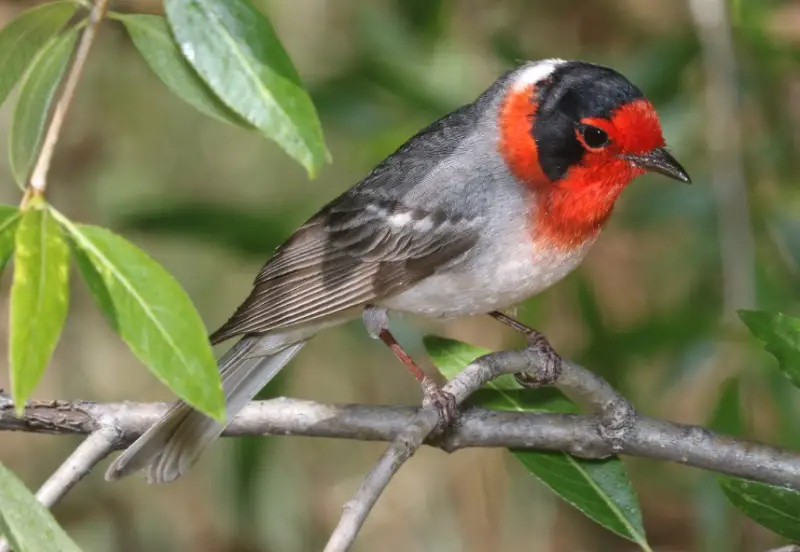
The Red-faced Warbler is a small, brightly colored bird about 4.3 to 5 inches long with a wingspan near 7.5 inches. It is easily recognized by its striking red face contrasted with black and white head markings and grayish body. This species is more commonly found in mountainous regions but occasionally reaches the southernmost parts of Florida during migration.
In Florida, Red-faced Warblers are rare migrants, usually seen in forested, high-elevation habitats with pine-oak woodlands. They forage actively in dense foliage, often in mixed-species flocks. Their soft, buzzy song and sharp calls help locate them when visible.
Behaviorally, Red-faced Warblers feed primarily on insects and spiders gleaned from leaves and branches. Their bright facial coloration and energetic foraging make them a favorite among birdwatchers. Florida’s forest patches provide occasional stopover habitat during their migration.
Grace’s Warbler (Setophaga graciae)

Grace’s Warbler is a small warbler measuring about 4.3 to 5 inches in length with a wingspan close to 7 inches. It features a striking black-and-white striped head, yellow throat and breast, and grayish back. This species is primarily a resident of pine forests in the southwestern U.S. but occasionally appears as a rare migrant in Florida.
In Florida, Grace’s Warblers are rare visitors, usually associated with mature pine woodlands during migration. They forage actively in pine canopies, gleaning insects from needles and branches. Their high-pitched, buzzy song is distinctive but often difficult to detect.
Behaviorally, Grace’s Warblers are agile and fast-moving, focusing on small insects and spiders. Their preference for pine habitats means they are rarely seen in Florida, but their occasional presence highlights the state’s role in supporting diverse warbler species during migration.
Painted Redstart (Myioborus pictus)
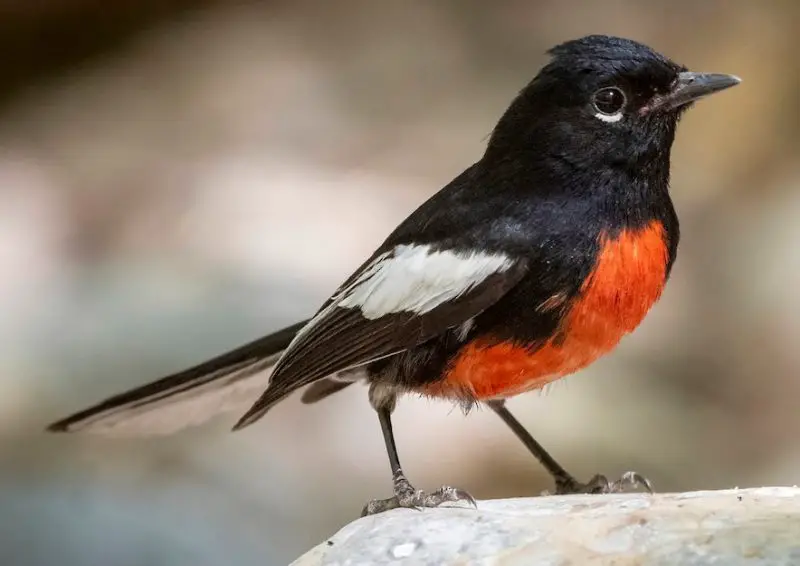
The Painted Redstart is a striking warbler about 4.5 to 5 inches long with a wingspan near 7.5 inches. It has glossy black plumage with bright white patches on the wings and tail, and vivid red patches on the face and chest. This species is more common in southwestern mountainous regions but is a rare visitor to Florida.
In Florida, Painted Redstarts are very rare migrants, typically found in forested areas with dense undergrowth. They forage actively by spreading their wings and tail to startle insects, a behavior unique among warblers. Their clear, melodious song is distinctive.
Behaviorally, Painted Redstarts feed primarily on flying insects, gleaning them from foliage and catching them in midair. Their striking coloration and active hunting style make them a memorable sight for Florida birders, even though sightings are uncommon.
Olive Warbler (Peucedramus taeniatus)
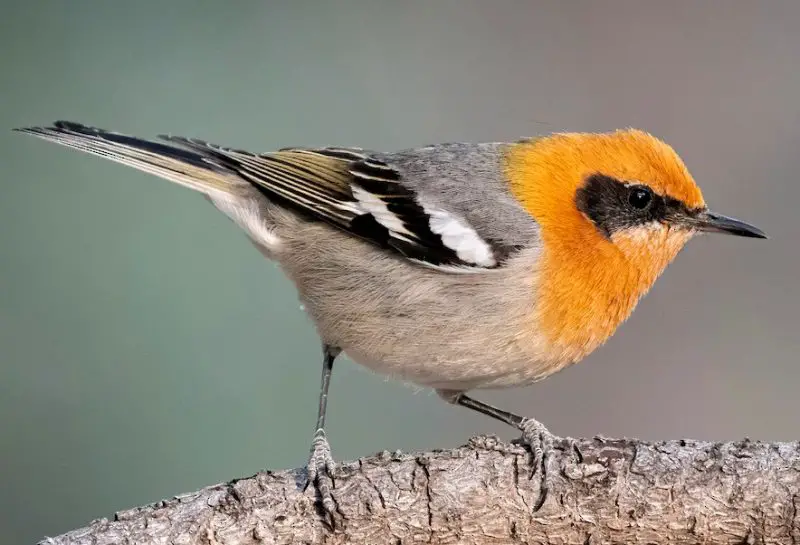
The Olive Warbler is a small bird measuring about 4.3 to 5 inches long with a wingspan near 7 inches. It is notable for its olive-green body and bright orange face and crown in males, while females are duller. Unlike most warblers, it belongs to its own unique family and is typically found in mountainous pine forests of the southwestern U.S.
In Florida, Olive Warblers are extremely rare and usually seen only as accidental migrants. When present, they are found in forested habitats with tall conifers and dense understory. Their thin, high-pitched calls are rarely heard in the region.
Behaviorally, Olive Warblers forage actively among pine needles and foliage for insects and spiders. Their distinct coloration and unique family classification make them an interesting species, though their presence in Florida is minimal and irregular.
Flame-throated Warbler (Oreothlypis gutturalis)
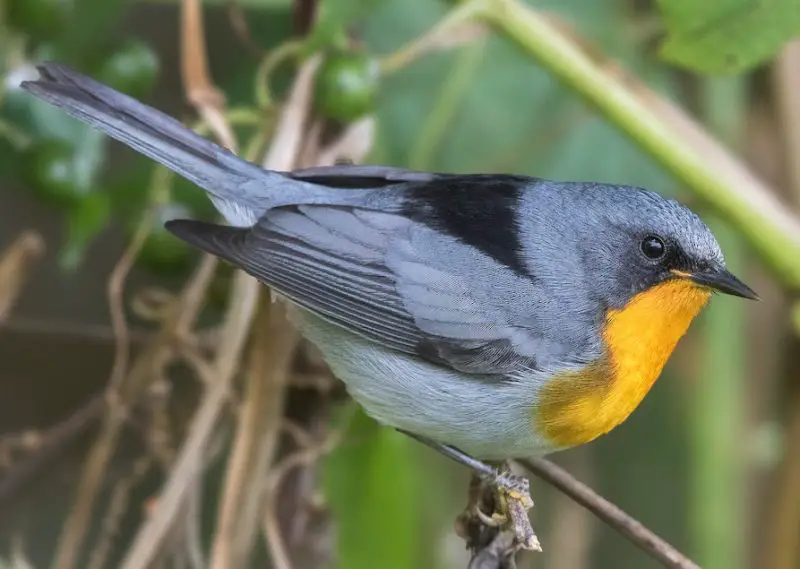
The Flame-throated Warbler is a small, brightly colored warbler approximately 4.3 inches in length with a wingspan around 6.5 inches. It has a vivid orange throat and upper chest, gray upperparts, and white underparts. This species is native primarily to Central American mountain forests and is not typically found in Florida.
In Florida, Flame-throated Warblers are extremely rare or accidental visitors, with few or no confirmed sightings. Their preferred habitat includes montane pine-oak forests, where they forage actively among the canopy. Their bright coloration and distinctive vocalizations are well known in their native range.
Behaviorally, they feed on insects and spiders gleaned from leaves and branches. While not a regular part of Florida’s avifauna, any potential sightings would be notable due to their rarity and striking appearance.
FAQs about Warblers Found in Florida
What types of warblers can be found in Florida?
Florida hosts a wide variety of warblers, including both resident and migratory species. Some common examples are the Yellow Warbler, Palm Warbler, Prothonotary Warbler, Ovenbird, and Black-and-white Warbler. Many warblers pass through Florida during migration seasons, making the state an important stopover site for these birds.
When is the best time to see warblers in Florida?
The best times to observe warblers in Florida are during the spring (March to May) and fall (September to November) migration periods. During these times, many species travel through Florida on their way to or from their breeding and wintering grounds. Some warblers also breed or winter in Florida and can be seen year-round.
What habitats do warblers prefer in Florida?
Warblers in Florida occupy a variety of habitats depending on the species. Many prefer wooded habitats such as pine forests, hardwood hammocks, and mangroves. Wetlands and swampy areas are favored by species like the Louisiana Waterthrush and Prothonotary Warbler. Open scrub and shrublands also provide important habitat for certain warblers.
How can I identify different warbler species in Florida?
Identification of warblers often depends on key features such as plumage colors, patterns, size, behavior, and song. Many warblers have distinctive markings like the black mask of the Common Yellowthroat or the bright yellow of the Palm Warbler. Listening to their songs and calls is also helpful, as many warblers have unique vocalizations.
Are warblers endangered or threatened in Florida?
Some warbler species face threats due to habitat loss, climate change, and other environmental pressures. For example, the Cerulean Warbler has experienced population declines and is considered a species of concern. Conservation efforts in Florida focus on protecting important habitats to support warbler populations during breeding, migration, and wintering periods.
What can I do to help protect warblers in Florida?
You can support warbler conservation by preserving and restoring natural habitats, planting native trees and shrubs, minimizing pesticide use, and supporting organizations dedicated to bird conservation. Responsible birdwatching, such as keeping a respectful distance and avoiding nest disturbance, also helps ensure warblers thrive in Florida.

